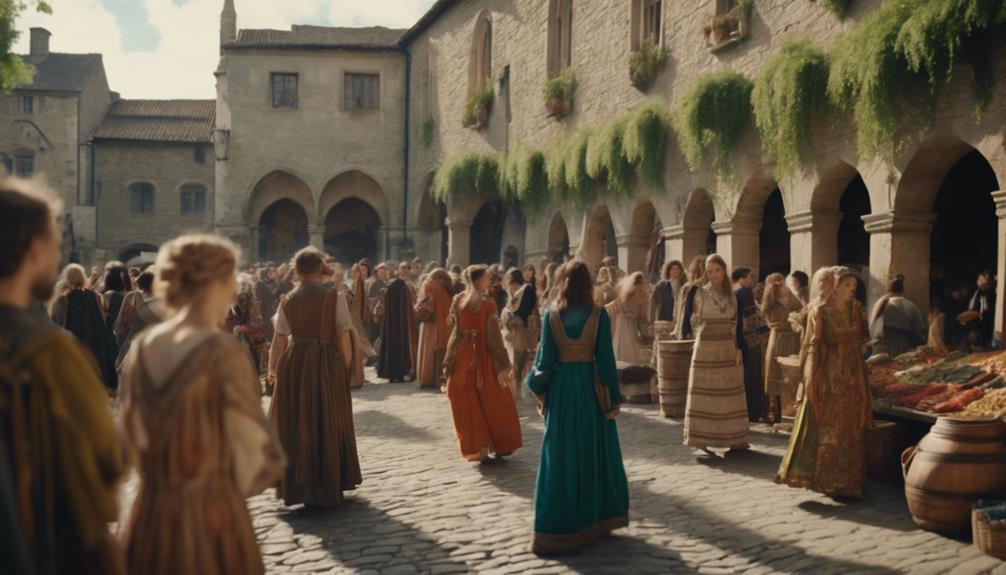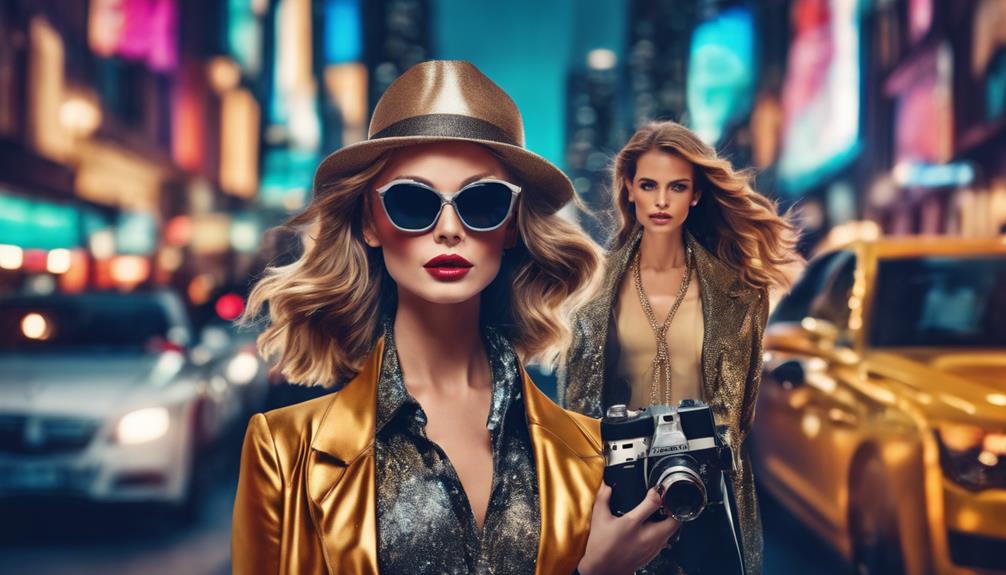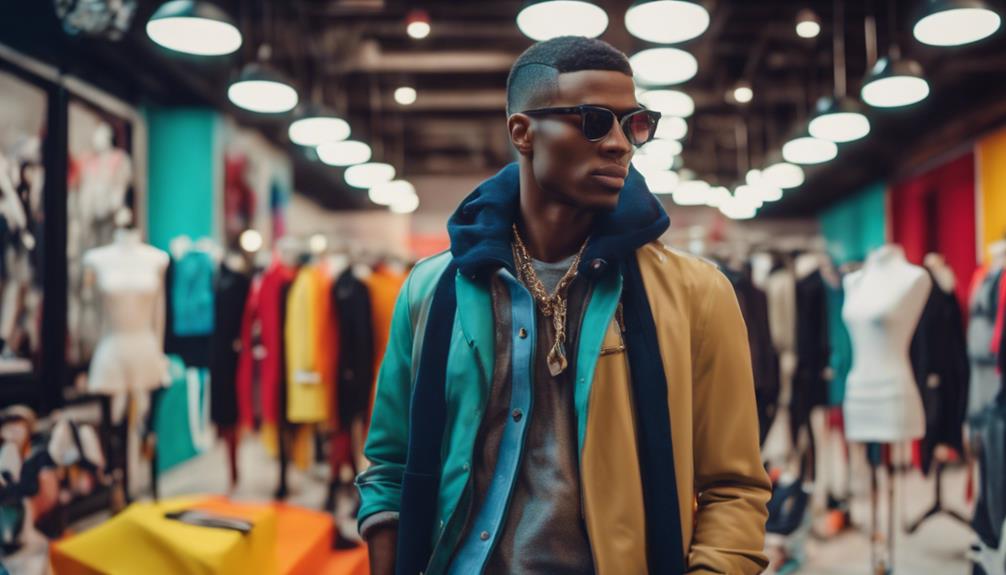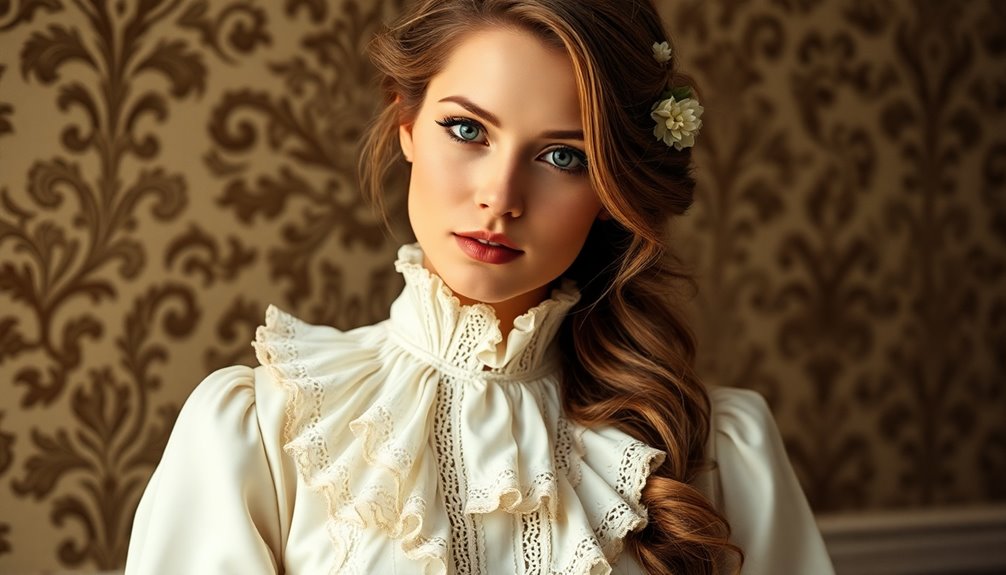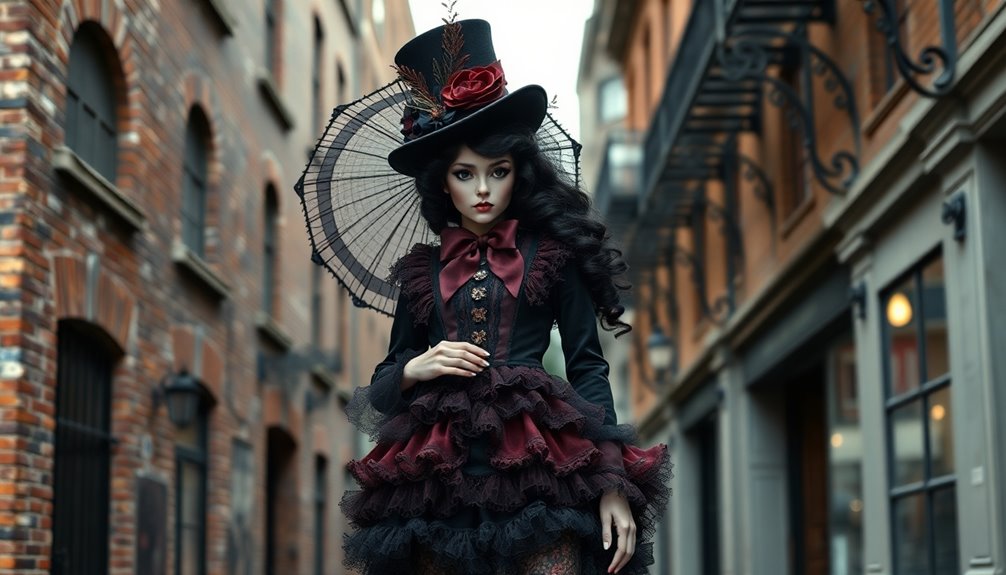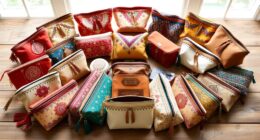Medieval fashion offers a peek into a period of gracefulness and skill. From luxurious fabrics like brocade to beautiful embroidery, each detail showcased social status and artistry. Muted earth tones were common for daily attire, while vibrant hues indicated nobility. Accessories such as brooches and belts completed authentic ensembles, highlighting individual style. Today, these timeless styles influence contemporary designers and environmentally-friendly practices, seamlessly blending the past with the present. If you’re interested in crafting your own medieval-inspired ensemble, there are numerous techniques and resources available to assist you in capturing that enchanting medieval essence.
Key Takeaways
- Medieval fashion showcased social status through luxurious fabrics, intricate patterns, and vibrant colors, often dictated by sumptuary laws.
- The introduction of spinning wheels and natural dyes revolutionized textile production, leading to elaborate garment designs.
- Essential medieval garments included tunics, cloaks, and the bliaut, each reflecting the wearer's rank and taste.
- Accessories like brooches and belts were crucial for completing outfits, emphasizing craftsmanship and social standing.
Origin and historical background of the fashion trend/style
To understand medieval fashion, you'll want to explore how textile techniques developed alongside the influence of religious institutions.
These elements shaped what people wore, reflecting their social standing and values.
You'll see how these factors intertwined, leading to the rich tapestry of styles we associate with the Middle Ages.
Development of Textile Techniques
The development of textile techniques during the Middle Ages transformed fashion, introducing innovations like the spinning wheel and advanced weaving methods that enabled the creation of intricate fabrics.
The 12th century saw the introduction of spinning wheels, which increased thread production efficiency, allowing for more elaborate designs. You'd find that natural dyes derived from plants, minerals, and insects provided a vibrant palette, with certain colors often reserved for nobility due to their cost and labor-intensive dyeing processes.
Weaving methods improved considerably, particularly with the horizontal loom, facilitating the production of complex patterns in textiles like brocade and damask, which were favored by the wealthy.
The emergence of guilds during this period was essential; they regulated the quality of textiles and the practices of weavers and dyers, ensuring high standards in garment production.
Additionally, innovations in fabric finishing techniques, such as fulling, enhanced the durability and quality of medieval garments, making them suitable for various social classes.
These advancements not only shaped the fashion of the time but also laid the groundwork for textile production in the centuries to come, reflecting a rich heritage that continues to influence modern design.
Religious Institutions and Their Impact
Shaping societal norms and aesthetics, religious institutions in the Middle Ages greatly influenced fashion trends by enforcing standards of modesty and simplicity in clothing. Clergy and nuns often adhered to these modesty standards, wearing tunics in subdued colors like black, gray, or white, which reflected their vows of humility.
The Church's authority extended to sumptuary laws that regulated what the laity could wear, dictating the types of fabrics and colors based on social status. This created a clear distinction in clothing choices across different classes.
Monastic communities emerged as crucial centers of textile production, crafting high-quality fabrics that weren't only accessible but also influenced local styles.
As you explore medieval fashion, you'll notice that garments often incorporated religious iconography and symbols, such as crosses and images of saints. These elements served to intertwine faith and fashion, making clothing a reflection of one's beliefs and societal position.
Key Characteristics
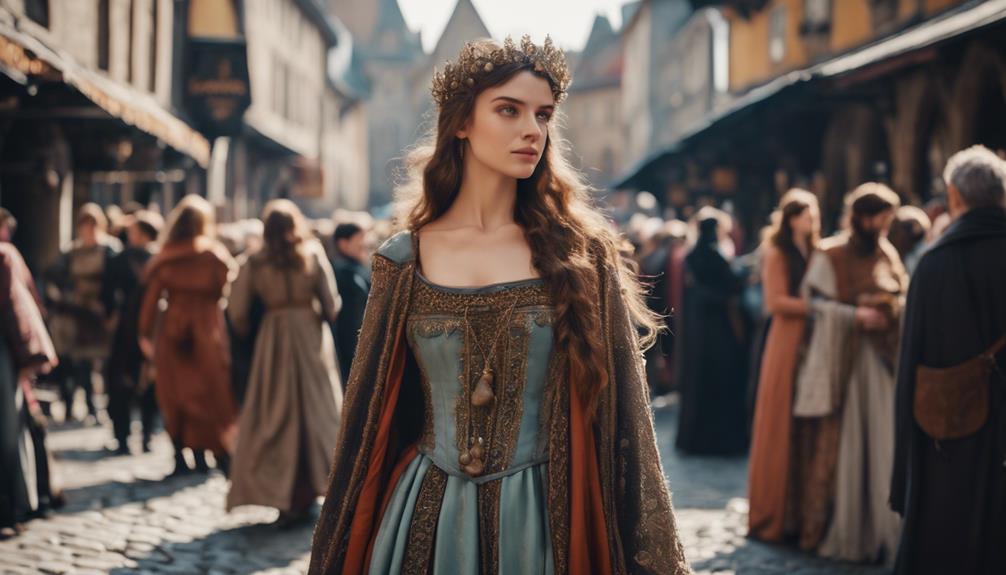
When you think about medieval fashion, you can't overlook the stunning embroidery and rich velvets that defined the era.
You'll notice how muted earth tones contrasted with vibrant colors, showcasing the wearer's status and taste.
Velvet cloaks and tunics were essential pieces that added elegance and warmth to both noble and common wardrobes.
Elaborate Embroidery and Embellishments
Elaborate embroidery and embellishments often adorned noblewomen's gowns, highlighting their wealth and social status during the High Middle Ages. These intricate designs weren't just for show; they showcased the skill of artisans and the quality of materials used. For instance, the bliaut, a popular garment in the 12th century, featured decorative embroidery that emphasized a woman's status.
Sumptuary laws played a vital role in this era, regulating who could wear richly embroidered garments. Only individuals of certain social classes could flaunt garments adorned with gold or silver threads, making these embellishments a clear indicator of rank. Common embellishments included gold braid and decorative clasps, which enhanced the aesthetic appeal and further reflected the wearer's taste.
As the late medieval period approached, the houppelande emerged as a voluminous gown, often richly embroidered and trimmed. This garment became a symbol of luxury and intricate craftsmanship, reinforcing the idea that fashion was deeply intertwined with social standing.
Through elaborate embroidery and embellishments, noblewomen of the High Middle Ages communicated their wealth and status, creating a lasting impression in the world of medieval fashion.
Rich Velvets and Muted Earth Tones
Rich velvets and subdued earth tones defined the wardrobe of both nobility and commoners during the medieval period, reflecting their social status and lifestyle. Nobility often showcased their wealth through garments made from rich velvets, featuring deep reds, blues, and vibrant greens, all made possible by high-quality dyes.
In contrast, the lower classes mainly wore subdued earth tones, with their clothing crafted from wool and linen dyed in natural colors like browns and grays, suitable for everyday wear.
Sumptuary laws played an essential role in this fashion landscape, dictating which luxurious fabrics could be worn by which social classes. While bright colors and intricate patterns were reserved for noble attire, the lower classes donned simpler, more subdued hues that were easier to maintain.
Accessories and embellishments, such as gold braid and embroidery, adorned rich velvets, elevating the elegance of the garments and clearly signaling the wearer's social standing.
This division in fashion not only reflected individual identity but also reinforced societal hierarchies, making rich velvets and subdued earth tones key characteristics of medieval style.
Velvet Cloaks and Tunics
Velvet cloaks and tunics epitomize medieval luxury, showcasing intricate designs and vibrant colors that signify the wearer's social standing. In medieval fashion, these garments were crafted from rich materials, making them symbols of wealth and status. Nobility often donned velvet cloaks adorned with embellishments, while tunics served as staple attire for both men and women.
The use of vibrant dyes in velvet cloaks and tunics played a significant role in medieval society. Deep hues like burgundy and royal blue were particularly fashionable among the elite, reflecting their higher social status. Layering was also essential; you'd typically wear a tunic under a cloak, providing both warmth and style. This practice enhanced the overall functionality and aesthetics of your outfit.
Accessories were critical in completing the look, with decorative belts and brooches frequently paired with tunics and cloaks. These items not only served practical purposes but also expressed personal wealth and identity during the Middle Ages.
Modern Interpretation
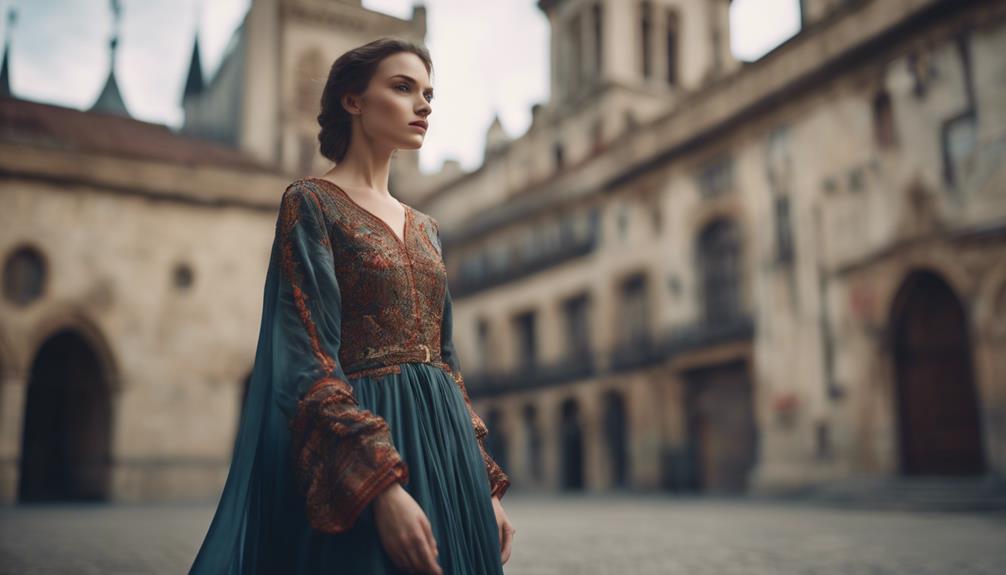
When you look at modern fashion, you'll notice a strong influence from medieval styles, especially in sustainable fabric choices and emerging fashion labels.
This blend not only honors historical craftsmanship but also reflects today's values of eco-consciousness.
Fashion icons of the era inspire contemporary designs, making medieval aesthetics both relevant and stylish in your wardrobe.
Sustainable Fabric Choices Emerging
As contemporary designers embrace the principles of sustainability, they're turning to organic cotton, linen, and recycled materials to create modern interpretations of medieval fashion. These sustainable fabric choices not only reduce environmental impact but also maintain a sense of historical authenticity.
Many of these designers draw inspiration from medieval dyeing techniques, opting for natural dyes derived from plants and minerals. This approach is less harmful to the ecosystem than synthetic alternatives.
The revival of traditional weaving methods further enhances the quality and craftsmanship of these textiles, supporting local artisans while reducing carbon footprints. Eco-friendly practices, like zero-waste patterns and biodegradable materials, are becoming increasingly popular, reflecting the resourcefulness and practicality that characterized medieval clothing.
Additionally, the trend of upcycling vintage garments into medieval-inspired pieces promotes sustainability by extending the lifecycle of clothing and greatly reducing textile waste in the fashion industry.
Sustainable Fashion Labels
Many sustainable fashion labels are reimagining medieval styles by using eco-friendly materials and ethical production methods to craft modern garments that honor historical aesthetics. These brands focus on timeless designs that reflect the beauty of medieval aesthetics, ensuring that each piece isn't only stylish but also enduring.
By incorporating traditional craftsmanship techniques, such as hand-weaving and natural dyeing, they create unique, high-quality items that stand out in today's fast-fashion world.
Sustainable fashion labels often prioritize organic fabrics like linen and cotton, which were staples during the Middle Ages, merging past with present. This return to roots promotes a deeper appreciation for clothing that lasts, encouraging you to invest in pieces that you can wear for years.
The rise of vintage clothing and upcycled clothing within this movement echoes the resourcefulness of medieval societies, where garments were frequently repurposed or modified.
Fashion Icons of the Era
Fashion icons from the medieval era, like Queen Eleanor of Aquitaine, still inspire modern designers with their lavish styles and intricate details. Her exquisite gowns and elaborate headdresses set trends that resonate today. The bliaut, a fitted garment popularized by noblewomen, highlights luxurious fabrics and refined designs, influencing contemporary interpretations of medieval elegance.
Knights, with their armor adorned in colorful heraldry, symbolize status and lineage, inspiring fantasy and historical costume designs. You'll find echoes of this in modern collections that celebrate strength and nobility. The surcoat, a versatile floor-length outer garment, has evolved, reflecting cultural shifts of the medieval period. Today, designers often reimagine these styles, incorporating them into themed clothing lines.
Accessories from the medieval period, such as decorative belts, brooches, and headdresses, continue to inspire contemporary jewelry and fashion. These elements emphasize the era's lasting impact on style, making them essential in modern wardrobes.
Styling Tips
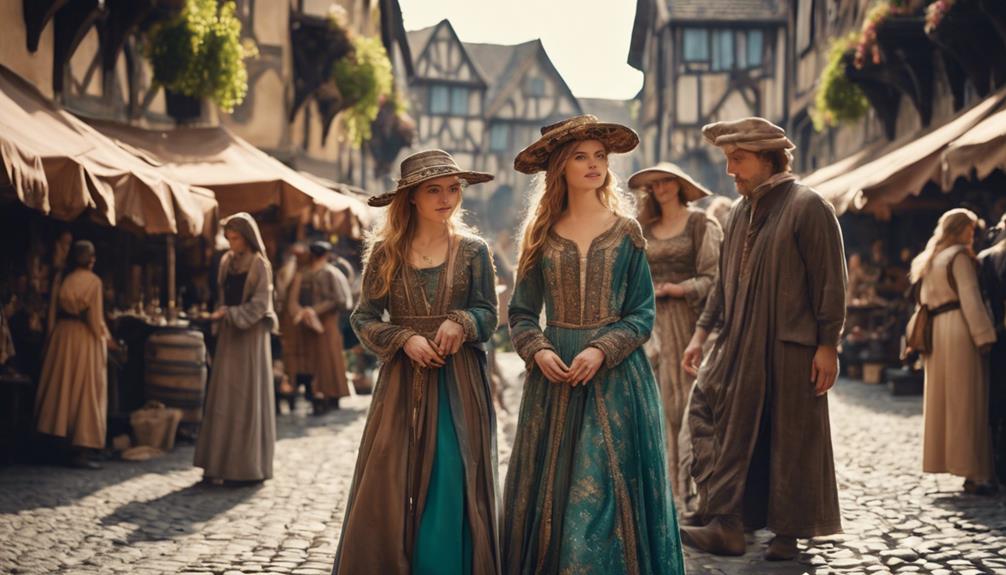
When you're putting together your medieval outfit, remember that layering is key for both style and warmth.
You'll want to combine different fabrics and textures, along with essential accessories like belts and brooches, to truly capture the essence of the era.
Don't forget to finish your look with a striking headpiece to complete your ensemble!
Essential Medieval Accessories List
To elevate your medieval ensemble, consider incorporating essential accessories like brooches, girdles, and distinctive footwear that reflect your unique style and status.
Brooches were more than just functional; they served as status symbols and showcased intricate craftsmanship. Use them to fasten your cloaks or simply as eye-catching adornments.
Girdles, typically made of leather or fabric, are great for cinching your waist while adding a decorative touch. They highlight your craftsmanship and can be an expression of personal style. Similarly, belts not only keep your tools and pouches in place but also enhance your outfit's aesthetic; look for those adorned with studs or intricate designs that speak to your social status.
When it comes to footwear, opt for leather boots or crakowes—pointed shoes that were all the rage in medieval times. These styles not only serve practical needs but also convey a sense of your standing within society.
Layered Tunic and Cloak Combinations
Layering a long linen tunic beneath a flowing cloak not only keeps you warm but also captures the essence of medieval style, merging practicality with elegance. To create an authentic look, consider pairing a fitted cotte with a voluminous houppelande. This combination enhances your silhouette, showcasing the contrasting styles popular during the High and Late Middle Ages.
When choosing your layered garments, opt for rich fabrics and vibrant colors to emulate the luxurious attire of the nobility. Textiles and dye quality were indicators of social status, so don't shy away from bold choices. A decorative girdle can cinch the waist of your tunic, adding structure and visual interest to your ensemble.
Additionally, cloaks, such as the heuke, serve as essential accessories, providing protection while acting as a fashionable outer layer. When you layer your garments thoughtfully, you not only adopt the aesthetic of medieval fashion but also embrace its functionality.
Layering Fabrics for Texture
Experimenting with different fabrics can elevate your medieval outfit, adding rich texture and depth that reflects the era's elegance. Layering fabrics is essential for creating visual interest in your garments. Start with a lightweight linen shift as your base layer, then add a tunic made from wool or silk. This combination not only provides warmth but also showcases the luxurious nature of the materials.
Don't forget accessories! A well-placed belt or girdle can enhance your silhouette while adding another layer of texture. Play with colors and patterns; richer hues and intricate designs can indicate your social status, making your medieval attire stand out.
Consider incorporating volume into your layers. Garments like the houppelande, which features multiple draping layers, can create an alluring shape. You'll find that the interplay of different fabrics and textures not only enhances your overall look but also pays homage to medieval fashion traditions.
Shopping Guide
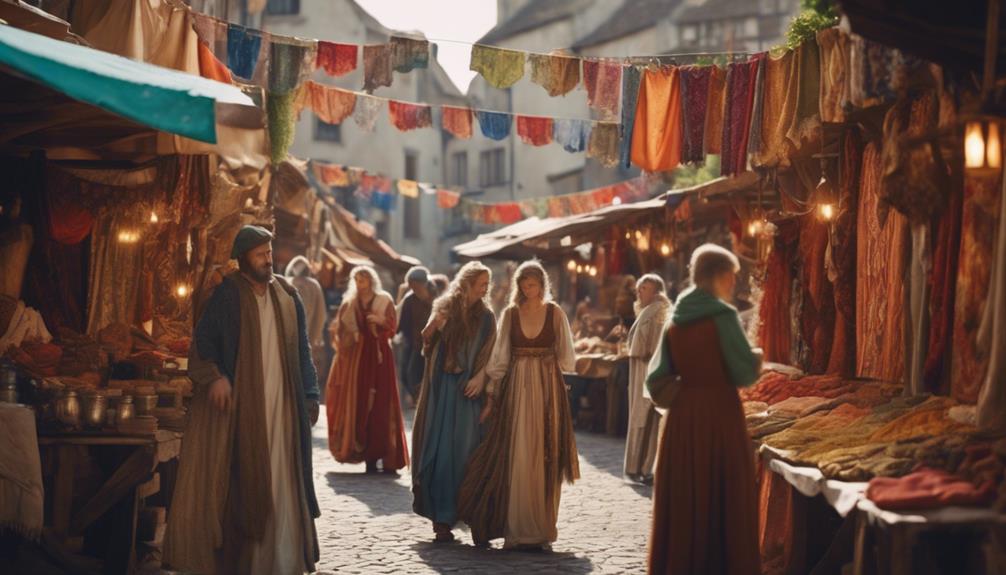
Finding authentic medieval fashion can be an exciting journey, especially with Medieworld.com's extensive collection that brings historical styles to life. You'll discover a variety of authentic clothing inspired by the Timeless Middle Ages, including long linen tunics and stylish leather boots.
Medieworld.com offers customization options, ensuring you get a perfect fit while maintaining historical accuracy. This way, you won't just wear a costume; you'll embody the spirit of the medieval era. Whether you're looking for the elegant Travelling Coat Prince Gilderoy at $209.00 or the classic XIII century long linen tunic for $134.00, there's something for every budget.
You'll also appreciate the reliable shipping services available internationally, including express options via UPS. This means you can easily access these medieval treasures from anywhere in the USA, UK, or Australia.
Plus, with regular updates on new products and closeouts, you'll always find fresh styles to enhance your medieval wardrobe. So, explore Medieworld.com today and elevate your medieval fashion game with authentic pieces that truly reflect the grandeur of the Middle Ages!
Handmade Medieval Costume Techniques
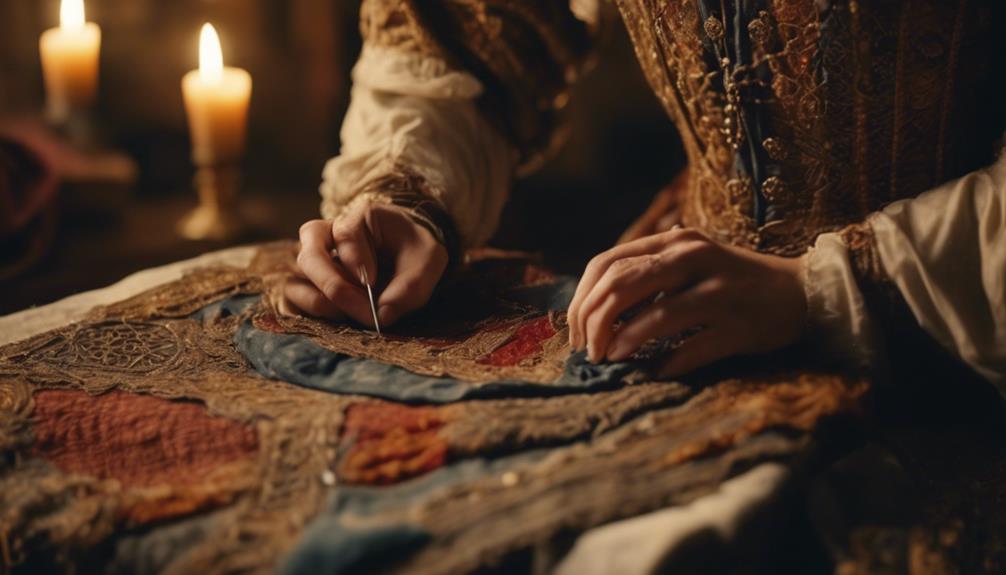
When you create a handmade medieval costume, mastering hand-sewing techniques is essential for authenticity.
You'll find that tailoring methods focus on simple shapes, allowing you to craft garments that fit comfortably while staying true to historical styles.
Hand-Sewing Medieval Costume Techniques
Hand-sewing medieval costumes demands a keen understanding of techniques like the running stitch and backstitch to guarantee both durability and authenticity in your creations. Without machine sewing, you'll rely on these hand-sewing techniques to construct garments that reflect historical accuracy. Use period-appropriate fabrics like linen, wool, and silk to enhance the authenticity of your costumes.
Pattern drafting is essential; focus on creating simple shapes that can be easily sewn together. Tunics and gowns often consist of rectangular pieces, providing ease of movement and comfort. Incorporate gathering and pleating to add volume and shape, especially in garments like the bliaut and houppelande.
Don't forget the importance of seam finishes for a polished look. They not only improve durability but also maintain the integrity of your costume.
Adding decorative elements like embroidery and appliqué allows for personal expression and showcases your skill. These embellishments also signify status through intricate designs.
Tailoring for Historical Accuracy
Tailoring for historical accuracy in medieval costumes requires a deep understanding of period techniques and materials. When creating handmade medieval costumes, you must prioritize using period-appropriate textiles like wool, linen, and silk. These fabrics not only enhance the authenticity of your garment but also provide the right texture that reflects the medieval era.
Incorporating traditional tailoring techniques is crucial. Methods such as darting and gathering are essential for constructing fitted garments like the bliaut and cotte. To achieve true historical accuracy, focus on hand-stitching methods, including backstitching and whipstitching. These techniques replicate the craftsmanship of medieval garment construction.
It's also important to take into account sumptuary laws, which dictated the design and color of clothing based on social status. Your choices should reflect these regulations to maintain authenticity. Additionally, embellishments like embroidery and appliqué should be meticulously crafted, showcasing your attention to detail.
Each stitch and decorative element enhances the overall appearance and communicates the wearer's wealth and style. By adhering to these guidelines, you can create a stunning, historically accurate medieval costume that stands out.
Cultural Impact
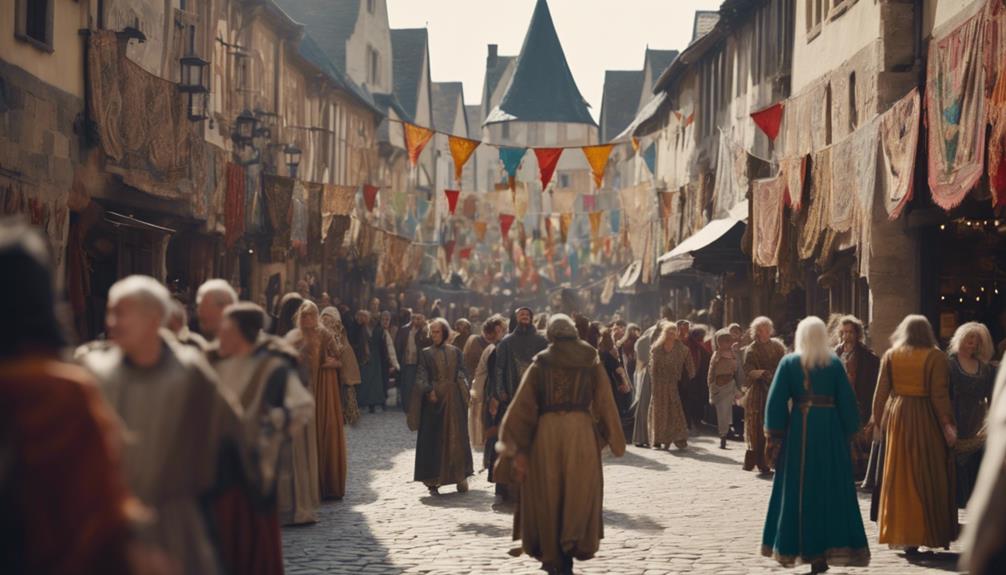
You can't ignore how shows like Game of Thrones have reignited interest in medieval fashion, making it a popular topic in modern culture.
Events like Renaissance fairs and historical reenactments encourage people to connect with the past through clothing, showcasing its lasting appeal.
This blend of entertainment and education keeps medieval styles alive, influencing how you think about fashion today.
Game of Thrones Influence
The cultural impact of 'Game of Thrones' has sparked a renewed fascination with medieval fashion, blending historical styles with modern aesthetics in a way that resonates with audiences today. The series showcased costumes designed by Michele Clapton, who drew heavily on medieval-inspired fashion while ensuring historical accuracy. You might've noticed the intricate designs and rich fabrics that brought the characters to life, highlighting their status and identity through fashion.
Layering became a key element in the series, with cloaks, belts, and jewelry accentuating the complex trends of the Middle Ages. As you watched, you could see how specific colors and materials symbolized character traits, much like in medieval attire. This attention to detail in the costumes not only captivated viewers but also influenced contemporary clothing lines, prompting many to explore medieval fashion for their own wardrobes.
The show's popularity has led to a resurgence in interest, inspiring both casual wear and elaborate costumes for events like cosplay conventions. By merging the past with the present, 'Game of Thrones' has undeniably left a lasting mark on how we perceive and embrace medieval-inspired fashion today.
Renaissance Fairs and Historical Reenactments
Celebrating the vibrancy of medieval fashion, Renaissance fairs and historical reenactments invite participants to fully immerse themselves in the culture and aesthetics of the Middle Ages.
You'll see attendees donning authentic costumes that reflect the intricate gowns of noblewomen and the sturdy armor of knights. These ensembles not only showcase the beauty of medieval fashion but also highlight the craftsmanship and social hierarchies of the time.
At these events, you can participate in workshops that teach period-appropriate crafting techniques, such as embroidery and leatherworking. This hands-on learning fosters a deeper appreciation for medieval history and the skills required to create such garments. Emphasizing authenticity, many participants research specific styles, ensuring their costumes are true to the era.
Beyond the attire, Renaissance fairs and historical reenactments serve as communal spaces where enthusiasts like you can share knowledge, engage in role-playing, and connect with others who've a passion for medieval history.
These gatherings create a vibrant community that keeps the spirit of the Middle Ages alive, encouraging everyone to celebrate and explore the fascinating world of medieval fashion together.
Frequently Asked Questions
What Are Some Styles From the Middle Ages?
You'd find styles like the fitted bliaut for women and tunics for men. The houppelande showcased wealth, while vibrant colors expressed social status, with red symbolizing nobility and blue often associated with the Virgin Mary.
What Type of Clothing Did Most People Wear in the Middle Ages?
In the Middle Ages, you'd typically wear simple tunics and cloaks, often belted for practicality. Women donned long dresses over chemises, while colors and accessories reflected your social status and wealth.
How Did Medieval Fashion Change Over Time?
Medieval fashion evolved considerably, starting with simple tunics and cloaks. As time passed, fitted garments and luxurious fabrics emerged, leading to dramatic silhouettes and tailored styles that reflected social status and wealth.
What Did Females Wear in Medieval Times?
In medieval times, you'd wear long, flowing dresses with layered linen shifts for comfort. Noblewomen favored fitted bliauts, while accessories like elaborate headdresses and jewelry showcased your social status and wealth.
How Did Medieval Fashion Influence Modern Mod Fashion?
The influence of medieval fashion on modern mod fashion vintage styles modern twist can be seen in the use of bold colors, statement accessories, and unique patterns. The use of velvet, brocade, and flowing silhouettes in medieval fashion has inspired modern designers to create a fresh take on vintage styles with a modern twist.
What are the similarities between Medieval Fashion and Old Money Fashion?
Both Medieval and Old Money fashion share timeless styles for classic looks. These styles often feature luxurious fabrics, intricate details, and elegant silhouettes that never go out of style. From opulent gowns to tailored suits, these fashion trends have transcended time to remain as relevant and stylish as ever.
Conclusion
To sum up, medieval fashion offers a unique blend of history and style that continues to inspire today.
By understanding its origins and key characteristics, you can embrace these timeless looks in your wardrobe.
Whether you're attending a themed event or simply want to add a touch of the past to your outfits, don't hesitate to experiment.
With the right styling tips and resources, you can effortlessly incorporate medieval elements into your modern fashion choices!
